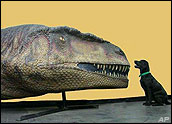
Archaeologists have learned that a pre-Hispanic pyramid recently found in a low-income, high-crime area about 30 miles north of Mexico City is 1,500 years old. They’ve been digging on the Iztapalapa hillside, known as the Hill of the Star, which is used for the annual re-enactment of Christ’s crucifixion prior to Easter.
The people who constructed the giant Pyramid of the Moon also built this unnamed pyramid in Teotihuacan, or the “City of the Gods,” as it is translated from the Mahuatl. It is Mexico’s largest ancient city.
“That pyramid has been known for a number of years; but what has not been known is its precise date, and it may prove to be circa 600 A.D. or later, since some of the material seems to be filled from earlier levels,” said David Frye, Ph.D., an adjunct assistant professor at the University of Michigan.
The find is significant because “it symbolizes the importance of the indigenous and European heritage mix in Mexico,” said Joel Palka, Ph.D., professor of Maya and Mesoamerican studies at the University of Illinois-Chicago. “Also, the Maya and Aztecs are well-known for their sacred temples on modified hills,” he added, “and now we have an earlier example from the Teotihuacan culture.”
State of the Pyramid
The site is only a few feet away from an annual crucifixion re-enactment in which a man who portrays Christ is tied to a cross. The event began in 1883, and about a million people flock to it every year.
The annual pilgrimage and the illegal construction of a number of houses on the hill have contributed to the disintegration of about half of the pyramid, even though it was hidden below two feet of dirt for protection. Archaeologists will fill in their excavation pits prior to next week’s crucifixion ritual to guard against further damage.
When they found ceramic fragments in the area several years ago, Jesus Sanchez, an archaeologist with the National Institute of Anthropology and History (INAH), and his team suspected there was a structure nearby. Miriam Advincula, a member of the team, mapped the site in 2004, and the group found the pyramid in 2005.
Ancient History
The recently discovered pyramid was built between A.D. 400 and 500. At 60 ft., it is as tall as a nine-story building, and it measures close to 500 feet on each side.
Its base is the same size as that of the nearby Pyramid of the Moon. The Pyramid of the Sun, also nearby, is the third largest in the world. The sun and moon pyramids were built between 1 A.D. and 250 A.D. and painted red. The population in the area grew between 250 and 450 A.D., making Teotihuacan the sixth largest city in the world.
The Teotihuacans abandoned the pyramid in 800 A.D., 300 years after its construction, when their culture fell apart. Later, another group known as the Coyotlatelcas partially rebuilt it.
Economic Boon
Archaeologists can’t completely excavate the pyramid because of the site’s religious significance. Both the pyramid and the Holy Week ritual are part of a revered cultural legacy. However, they can still conduct excavations with purposeful and careful planning.
“Archaeologists can do a lot to learn more about the temple construction and the ancient indigenous religious beliefs associated with it,” said Palka.
The find opens employment opportunities, providing local residents with needed income. Furthermore, the low-income district will benefit from the increase in tourism.
Palka expects archaeologist will excavate narrow portions of the architecture and dig away from the crucifixion shrine, perhaps opening a tunnel into the pyramid.
“We await a chance to see the building plan and all the ceramics associated with it, particularly any caches or deposits in situ. It’s an exciting project,” said Frye.



















































